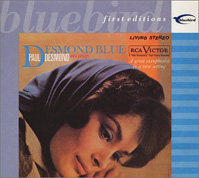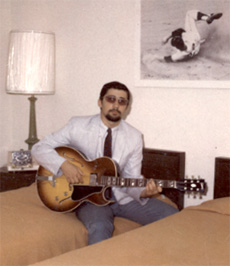|
Amazing that a
very brief 12-bar solo could solo could contain so many
little pearls of musical information, but such is the
case with Jim Hall's little gem of a solo on
Paul Desmond's minor blues in Eb titled, "Desmond
Blue." Recorded on October 2nd, 1961, this tune
appeared originally on the LP, "DESMOND BLUE"(RCA),
Paul Desmond with strings. Having already expressed
my great admiration for all of Hall's recorded work
with Desmond, there's no need to go into it again here. Having already expressed
my great admiration for all of Hall's recorded work
with Desmond, there's no need to go into it again here.
The solo itself appears near the very end of the tune
and just before Desmond returns to restate the melody.
There doesn't appear to have been any editing done,
so it actually seems to be a one chorus, 12-bar solo
which remains extremely hard to believe. That stated,
let's take a look at the solo phrase by phrase.
And, from a very guitar oriented perspective.
Though it's not always
true, where the guitar is concerned, I think one has
to remember that when a player is soloing, especially
as the solo begins, they are likely to be in place,
an 'area' on the instrument which feels comfortable
for them. Often times you can locate that area by just
reducing the guitar to three fundamental areas, or positions.
Those positions would be closely related to where the
roots of the first chord would be on either the low
'E'-string or the 'A'-string. In
this case, where we're looking at Ebm7, you would
mostly likely be looking at the area around the 6th
fret where we find Eb on the 'A'-string. I
think the tone might tell us if Jim Hall had been playing
in the area of the 11th fret where Eb is on the low
'E'-string. Generally speaking, unless a melody
section ended in the high register, one would want to
begin a solo where their tone is at its most warm. Now,
let's see if this small piece of 'wisdom'
turns out to be true.
Jim begins his solo by
playing the root, an Eb, and it's my guess that
this note is located on the 8th fret on the 'G'-string.
So, we are exactly where I would have expected him to
be. In this first phrase, which begins in bar 1 and
extends through bar 3, you will notice Hall's usage
of the 'D'-natural as a lower neighbor to
the root of Eb. Especially because this is a blues,
you might expect to see more Dbs. Though this solo is
so very brief, at times, it's almost as if Hall
is utilizing the Eb harmonic minor scale(Eb, F, Gb,
Ab, Bb, Cb, D). Where the 'blues' is concerned,
you will notice Jim's usage of the 'A'-natural,
a 'blue note,' in bar 2.
When we've spoken about
playing over blues changes before, we've always made
note of the fact that it is in bar 4 when you really
want to emphasize, from time to time, that here your
I7 chord or, in this case, your im7 chord becomes a
V7(alt.) chord to pull you towards the IV chord. Again
in this case, as it's a minor blues, you're headed towards
a ivm7. During this solo, in bar 4, Jim Hall begins
a long phrase with an arpeggiated idea which outlines
tones from what could be thought of as an Eb7(b9) chord
which could be viewed as placing an E°7/G°7/Bb°7/Db°7
on top of the root... obviously they all contain the
same notes. In Hall's grouping of triplets, he sticks
to this arpeggio until the 'G'-natural becomes the 'leading
tone' to Abm7. As Hall arrives at the ivm7 chord, you
can see the outline of the minor triad and then some
scale/modal tones in Ab Dorian(Ab, Bb, Cb, Db, Eb, F,
Gb). However, again you see the major 7th('G'-natural)
used as a lower neighbor to the root. This occurs as
bar 5 moves into bar 6. You can also hear the extreme
change of tone in bar 6 when Jim goes from Ab on his
'D'-string to Bb on his low 'E'-string. You can hear
his little amp "crying for help." This phrase
concludes with an 'answer' phrase where Jim uses the
colorful tone of the 6th, a lower register 'C'-natural
in bar 7.
As he did in bar 4, in
bar 8 Jim uses the rhythmic grouping of triplets to
move towards the V7(alt.) chord, Bb7(alt.). Notice how
both phrases began on the 2nd 8th-note triplet of beat
2, a small detail. But, players tend to play what they
are comfortable with and this pertains to the notes,
and their rhythms. Though we are still on an Ebm7 chord,
it seems that Jim is using its personal V7 chord(Ab7)
in his line. Notice how beautifully the line climbs
until Hall has arrived at an 'E'-natural,
the b5 of Bb7 and then he drops down immediately to
a 'B'-natural, the b9 of Bb7. What enables
Hall to feel so harmonically 'free' during
this solo is that there is no harmonic accompaniment,
so anything you hear is possible. And, for those of
us who love the 'naked' aspect of the guitar
trio, what could be better?
Hall then takes those
two notes and turns them into a jumping-off point and
simply expands on the idea as he ascends the neck of
the guitar. He does this with a series of short, choppy
triplet phrases from bar 9 through bar 11. He first
outlines an 'E' triad, but with the chord's root, Bb,
added. So, he's spelling out a Bb7(b5, b9) chord. As
he ascends he outlines another familiar guitar voicing
by its individual notes giving us the familiar motion
from #9-b9 to the #5 and finally the 3rd. If you were
to finger the chord in full, you would see that this
is a very common guitar voicing for a Bb7(#9, #5) chord.
Finally, Jim Hall arrives at the root of our im7 chord,
Ebm7, and he arrives there AHEAD of the bar in
which it appears, bar 11.
As the solo comes to an
end, you again see Hall's usage of 'D'-natural as a
chromatic lower neighbor to our root, and an 'F'-natural
as the consonant upper neighbor. That only means that
'F'-natural is part of the Eb Dorian mode(Eb, F, Gb,
Ab, Bb, C, Db). What's remarkable as the solo comes
to an end is that there a little phrase, almost a 'throwaway'
phrase but the phrase which begins with four 16th-notes
at the end of bar 11. This little phrase, to me, is
a real "Jim Hall-ism," and is the kind of
guitar phrasing which has influenced countless guitarists.
Amongst your favorites might be: John Abercrombie,
John Scofield and Pat Metheny. Once again
it appears that this phrase is more closely related
to the Eb harmonic minor scale than to Eb 'blues' material,
or Eb-Dorian material.
 To get very technical,
and only for the guitarists, about this one little phrase,
I would finger the first Bb on my 'B'-string at the
11th fret with my pinky. The Db would be played on the
high 'E'-string by my 2nd finger; the 'C'-natural would
be played with my 1st finger. The Bb is again played
with my pinky on the 'B'-string. Finally the Cb is played
with my 1st finger and on the 'E'-string as is the Bb.
The Ab and Gb are both played on the 'B'-string and
respectively by my pinky and 2nd finger. I believe that
can you give your playing more of a 'swing' when a line
is going up or down the neck, as opposed to across the
stings, by using the same fingers, because it forces
the smallest of spaces between the notes. It's that
little space which gives the line a natural swing. As
the solo comes to a close, Hall beautifully dovetails
his last phrase, bar 12, into a counter line which he
plays underneath Paul Desmond's melody as [A]
returns. It's interesting to note that his last phrase
is a small variation of his very first phrase played
in bar 1. There, the last four 8th-notes were: Gb-F-Eb-D
to Eb; and in bar 12 you now have: Gb-Eb-F-D to Eb.
It gives the solo a very intuitive continuity.
To get very technical,
and only for the guitarists, about this one little phrase,
I would finger the first Bb on my 'B'-string at the
11th fret with my pinky. The Db would be played on the
high 'E'-string by my 2nd finger; the 'C'-natural would
be played with my 1st finger. The Bb is again played
with my pinky on the 'B'-string. Finally the Cb is played
with my 1st finger and on the 'E'-string as is the Bb.
The Ab and Gb are both played on the 'B'-string and
respectively by my pinky and 2nd finger. I believe that
can you give your playing more of a 'swing' when a line
is going up or down the neck, as opposed to across the
stings, by using the same fingers, because it forces
the smallest of spaces between the notes. It's that
little space which gives the line a natural swing. As
the solo comes to a close, Hall beautifully dovetails
his last phrase, bar 12, into a counter line which he
plays underneath Paul Desmond's melody as [A]
returns. It's interesting to note that his last phrase
is a small variation of his very first phrase played
in bar 1. There, the last four 8th-notes were: Gb-F-Eb-D
to Eb; and in bar 12 you now have: Gb-Eb-F-D to Eb.
It gives the solo a very intuitive continuity.
When all is said and done,
this one chorus, 12-bar solo, has almost spanned the
entire range of the guitar traveling from a low Bb to
a high 'F.' And, that distance feels as though it has
happened in a completely natural way. While I suppose
that most of us would say that we wish Jim Hall had
been allowed a more open-ended soloing format, I think
that, in the end, as some might say, it's better
to leave everyone wanting more, than to have them hoping
that you would stop! Jim Hall, as he almost always
does, has used the allotted space beautifully.
As always, thanks so much
for your faithful visits to the newly arrived KHAN'S
KORNER 1. It continues to be a most remarkable thing
to view the popularity of these pages. Thank you!!!
[Polaroid Photo of Steve and his Gibson ES-175 ca. 1968, while attending U.C.L.A., and, once again, trying to look as cool as Charles Lloyd did on his cover of "DREAM WEAVER" which featured the tune, "Sombrero Sam." But, in the end, just another Jim Hall-wanna-be!! Oh, and by the way, that's a photo of New York Giant, Don Mueller "sliding in" to 2nd base! Nice plastic cover on the lampshade too!!!]
|

